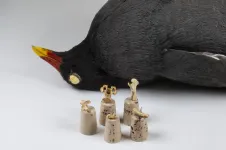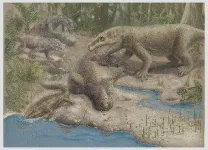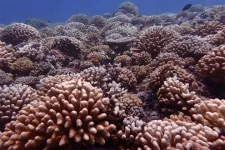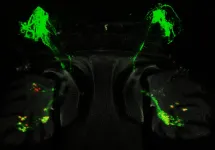(Press-News.org) GAINESVILLE, Fla. --- In a genetic surprise, ancient DNA shows the closest family members of an extinct bird known as the Haitian cave-rail are not in the Americas, but Africa and the South Pacific, uncovering an unexpected link between Caribbean bird life and the Old World.
Like many animals unique to the Caribbean, cave-rails became extinct soon after people settled the islands. The last of three known West Indian species of cave-rails - flightless, chicken-sized birds - vanished within the past 1,000 years. Florida Museum of Natural History researchers sought to resolve the group's long-debated ancestry by analyzing DNA from a fossil toe bone of the Haitian cave-rail, Nesotrochis steganinos. But they were unprepared for the results: The genus Nesotrochis is most closely related to the flufftails, flying birds that live in sub-Saharan Africa, Madagascar and New Guinea, and the adzebills, large, extinct, flightless birds native to New Zealand.
The study presents the first example of a Caribbean bird whose closest relatives live in the Old World, showcasing the power of ancient DNA to reveal a history erased by humans.
The discovery was "just mind-blowing," said study lead author Jessica Oswald, who began the project as a postdoctoral researcher at the Florida Museum.
"If this study had not happened, we might still be under the assumption that the closest relatives of most things in the Caribbean are on the mainland in the Americas," said Oswald, now a postdoctoral researcher at the University of Nevada, Reno and a Florida Museum research affiliate. "This gives us an understanding of the region's biodiversity that would otherwise be obscured."
Many animals evolved unusual forms on islands, often making it difficult to classify extinct species based on their physical characteristics alone. But advancements in extracting viable DNA from fossils now enables scientists like Oswald to answer longstanding questions with ancient genetic evidence. Oswald described her work as similar to a forensic investigation, tracing the evolutionary backstory of extinct animals by piecing together fragmented, degraded genetic material.
"Understanding where all of these extinct species fit into a larger family tree or evolutionary history gives us insight into what a place looked like before people arrived," she said. "That's why my job is so fun. It's always this whodunit."
Oswald was just starting her ancient DNA work at the Florida Museum when David Steadman, curator of ornithology and study co-author, suggested the Haitian cave-rail as a good candidate for analysis.
Cave-rails share physical characteristics with several types of modern birds, and scientists have conjectured for decades whether they are most closely related to wood rails, coots or swamphens - birds that all belong to the rail family, part of a larger group known as the Gruiformes. Oswald and Steadman hoped that studying cave-rail DNA would clarify "what the heck this thing is," Oswald said.
When preliminary results indicated the species had a trans-Atlantic connection, Steadman, who has worked in the Caribbean for more than 40 years, was skeptical.
The genetics also showed that the cave-rail isn't a rail at all: While flufftails and adzebills are also members of the Gruiformes, they are in separate families from rails.
"It just didn't seem logical that you'd have to go across the Atlantic to find the closest relative," Steadman said. "But the fact that people had a hard time classifying where Nesotrochis was within the rails - in hindsight, maybe that should have been a clue. Now I have a much more open mind."
One reason the cave-rail was so difficult to classify is that when birds lose the ability to fly, they often converge on a similar body plan, Steadman said. Flightlessness is a common adaptation in island birds, which face far fewer predators in the absence of humans and invasive species such as dogs, cats, rats and pigs.
"You don't have to outfly or outrun predators, so your flying and running abilities become reduced," Steadman said. "Because island birds spend less energy avoiding predators, they also tend to have a lower metabolic rate and nest on the ground. It's no longer life in the fast lane. They're essentially living in a Corona commercial."
While sheltered from the mass extinctions that swept the mainland, cave-rails were helpless once people touched foot on the islands, having lost their defenses and cautiousness.
"Being flightless and plump was not a great strategy during human colonization of the Caribbean," said study co-author Robert Guralnick, Florida Museum curator of biodiversity informatics.
How did cave-rails get to the Caribbean in the first place? Monkeys and capybara-like rodents journeyed from Africa to the New World about 25-36 million years ago, likely by rafting, and cave-rails may also have migrated during that timespan, Steadman said. He and Oswald envision two probable scenarios: The ancestors of cave-rails either made a long-distance flight across an Atlantic Ocean that was not much narrower than today, or the group was once more widespread across the continents, with more relatives remaining to be discovered in the fossil record.
Other researchers have recently published findings that corroborate the story told by cave-rail DNA: A study of foot features suggested Nesotrochis could be more closely related to flufftails than rails, and other research showed that adzebills are close relatives of the flufftails. Like cave-rails, adzebills are also an example of a flightless island bird extinguished by human hunters.
"Humans have meddled so much in the region and caused so many extinctions, we need ancient DNA to help us sort out what's related to what," Oswald said.
The findings also underscore the value of museum collections, Steadman said. The toe bone Oswald used in her analysis was collected in 1983 by Charles Woods, then the Florida Museum's curator of mammals. At that time, "nobody was thinking about ancient DNA," Steadman said. "It shows the beauty of keeping things well curated in a museum."
INFORMATION:
Ryan Terrill of Occidental College, the Florida Museum's Brian Stucky and Michelle LeFebvre and Julie Allen of the University of Nevada, Reno, and the University of Illinois Urbana-Champaign also co-authored the study.
SAN FRANCISCO (March 16, 2021) - Over the course of Earth's history, several mass extinction events have destroyed ecosystems, including one that famously wiped out the dinosaurs. But none were as devastating as "The Great Dying," which took place 252 million years ago during the end of the Permian period. A new study, published today in Proceedings of the Royal Society B, shows in detail how life recovered in comparison to two smaller extinction events. The international study team--composed of researchers from the China University of Geosciences, the California Academy of Sciences, the University of Bristol, ...
(Vienna, March 17, 2021) When complex systems double in size, many of their parts do not. Characteristically, some aspects will grow by only about 80 percent, others by about 120 percent. The astonishing uniformity of these two growth rates is known as "scaling laws." Scaling laws are observed everywhere in the world, from biology to physical systems. They also apply to cities. Yet, while a multitude of examples show their presence, reasons for their emergence are still a matter of debate.
A new publication in the Journal of The Royal Society Interface now provides a simple explanation for urban scaling laws: Carlos Molinero and Stefan Thurner of the Complexity Science Hub Vienna (CSH) derive them from the geometry of a city.
Scaling laws in ...
The UK variant of SARS-CoV-2 spread rapidly in care homes in England in November and December last year, broadly reflecting its spread in the general population, according to a study by UCL researchers.
The study, published as a letter in the New England Journal of Medicine, looked at positive PCR tests of care home staff and residents between October and December. It found that, among the samples it had access to, the proportion of infections caused by the new variant rose from 12% in the week beginning 23 November to 60% of positive cases just two weeks later, in the week beginning 7 December.
In the south east of England, where the variant was most dominant, the proportion increased from 55% to 80% over the same period. In London, where the variant spread fastest, ...
Washington, DC, March 16, 2021 - A study in the Journal of the American Academy of Child and Adolescent Psychiatry (JAACAP), published by Elsevier, reports on the young adult assessment of the now 20-year longitudinal Boricua Youth Study (BYS), a large cohort that brings much needed insight about development and mental health of children from diverse ethnic background growing up in disadvantaged contexts.
The present article, with its companion report on prevalence of conditions and associated factors, provides an update on the study's fourth wave, which follows-up two probability-based population samples of children of Puerto Rican heritage. ...
Certain brightly colored coral species dotting the seafloor may appear indistinguishable to many divers and snorkelers, but Florida State University researchers have found that these genetically diverse marine invertebrates vary in their response to ocean warming, a finding that has implications for the long-term health of coral reefs.
The researchers used molecular genetics to differentiate among corals that look nearly identical and to understand which species best coped with thermal stress. Their research was published in the journal Ecology.
"Being able to recognize the differences among these coral species that cannot be identified in the field -- which are known as 'cryptic species' -- will help us understand new ways ...
The electron is one of the fundamental particles in nature we read about in school. Its behavior holds clues to new ways to store digital data.
In a study published in Nano Letters, physicists from Michigan Technological University explore alternative materials to improve capacity and shrink the size of digital data storage technologies. Ranjit Pati, professor of physics at Michigan Tech, led the study and explains the physics behind his team's new nanowire design.
"Thanks to a property called spin, electrons behave like tiny magnets," Pati said. "Similar to how a bar magnet's magnetization is dipolar, pointing from south to north, ...
The Volcano Alert Level (VAL) system, standardized by the United States Geological Survey (USGS) in 2006, is meant to save lives and keep citizens living in the shadow of an active volcano informed of their current level of risk.
A new study published in Risk Analysis suggests that, when an alert remains elevated at any level above "normal" due to a period of volcanic unrest, it can cause a decline in the region's housing prices and other economic indicators. Because of this, the authors argue that federal policymakers may need to account for the effects of prolonged volcanic unrest -- not just destructive eruptions -- in the provision of disaster relief funding.
A team of geoscientists and statistical experts examined the historical relationship ...
As researchers push the boundaries of battery design, seeking to pack ever greater amounts of power and energy into a given amount of space or weight, one of the more promising technologies being studied is lithium-ion batteries that use a solid electrolyte material between the two electrodes, rather than the typical liquid.
But such batteries have been plagued by a tendency for branch-like projections of metal called dendrites to form on one of the electrodes, eventually bridging the electrolyte and shorting out the battery cell. Now, researchers at MIT and elsewhere have found ...
Even though a fruit fly doesn't have ears, it can hear with its antennae. In a END ...
The first known study to explore optimal outpatient exam scheduling given the flexibility of inpatient exams has resulted in shorter wait times for magnetic resonance imaging (MRI) patients at END ...




